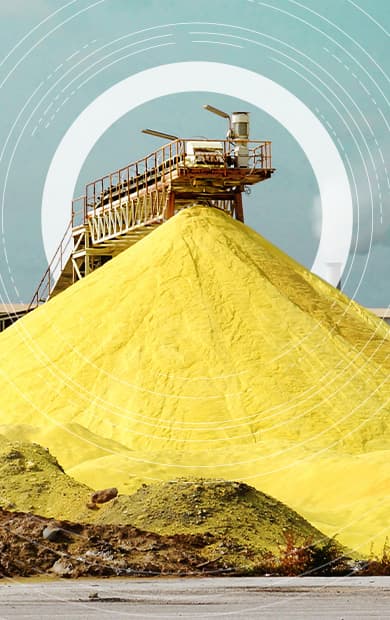Overview
The global sulphur market has gone through fundamental changes in buying patterns, trade routes and pricing over the past few years. Fixed price contracts and formula-based indexation have become the dominant ways in which supplies are bought and sold around the world, which makes accurate price assessments and detailed analysis key to any sulphur market participants.
The global sulphuric acid industry has seen structural change in recent years and new capacities will continue to challenge the balance in the years to come. While demand will be driven by fertilizers — predominantly the increased production of phosphate and ammonium sulphates — the market will continue to be exposed to short-term supply shocks, especially from the metals sector.
Rising demand for battery materials such as nickel and cobalt (due to growing electric vehicle production) will in turn bolster demand for sulphur and sulphuric acid, increase competition for supply and impact pricing.
Our extensive market coverage includes formed sulphur (both granular and prilled), crushed lump sulphur, molten/liquid sulphur and sulphuric acid. Argus has decades of experience covering these markets, and incorporate our multi-commodity market expertise in key areas including phosphates and metals to provide the full market narrative.
Argus support market participants with:
- Price assessments (daily and weekly for sulphur, weekly for sulphuric acid), proprietary data and market commentary assessments
- Short and medium to long-term forecasting, modelling and analysis of sulphur and sulphuric acid prices, supply, demand, trade and projects
- Bespoke consulting project support
Latest sulphur and sulphuric acid news
Browse the latest market moving news on the global sulphur and sulphuric acid industry.
Abu Dhabi's Adnoc raises Jan sulphur price by $25/t
Abu Dhabi's Adnoc raises Jan sulphur price by $25/t
London, 31 December (Argus) — Abu Dhabi's state-owned Adnoc has set its January sulphur official selling price (OSP) for the Indian subcontinent at $520/t fob Ruwais, up by $25/t from its December OSP. Adnoc's January OSP implies a delivered price of $536-538/t cfr India, with the freight cost for a 40,000-45,000t shipment to the east coast of India last assessed at $16-18/t on 18 December. By Maria Mosquera Send comments and request more information at feedback@argusmedia.com Copyright © 2025. Argus Media group . All rights reserved.
Kuwait's KPC raises Dec sulphur price by $95/t
Kuwait's KPC raises Dec sulphur price by $95/t
London, 2 December (Argus) — Kuwait's state-owned sulphur producer KPC has set its December Kuwait Sulphur Price (KSP) at $495/t fob Kuwait, up by $95/t from the October KSP. The December KSP implies a delivered price to China of $517-521/t cfr at current freight rates, which were assessed on 27 November at $22-24/t to south China and at $24-26/t to Chinese river ports for a 30,000-35,000t shipment. Following substantial monthly increments to the KSP price in the past three months, the December level has now risen $5/t above the peak reached in June 2022 at $490/t fob Kuwait. This announcement follows the Qatari December price announcement made on 30 November at the same level . Sulphur prices have been firming this year, with new sulphur burning capacity brought on line in Morocco for fertilizer production and in Indonesia for nickel refining. And supply has become constrained as much of Russian sulphur production has gone off line as a result of conflict-related damage to oil and gas processing sites. The recent price increases have made sulphur unaffordable for many fertilizer producers, sulphuric acid sellers and chemical companies — but to date demand erosion has not been sufficient to offset the rising trend. By Maria Mosquera Send comments and request more information at feedback@argusmedia.com Copyright © 2025. Argus Media group . All rights reserved.
QatarEnergy raises December sulphur price by $95/t
QatarEnergy raises December sulphur price by $95/t
London, 30 November (Argus) — State-owned QatarEnergy Marketing has raised its December Qatar Sulphur Price (QSP) to $495/t fob, up by a substantial $95/t from $400/t fob Ras Laffan/Mesaieed for November. The December QSP implies a delivered price to China of $517-521/t cfr at current freight rates, which were assessed on 27 November at $22-24/t to south China and at $24-26/t to Chinese river ports for a 30,000-35,000t shipment. The December QSP has now surpassed the highest level seen during the commodity price peak in July 2022, when it reached $490/t fob. This was followed by a steep drop to $77/t fob in August 2022. By Maria Mosquera Send comments and request more information at feedback@argusmedia.com Copyright © 2025. Argus Media group . All rights reserved.
Turkey's Tupras awards sulphur e-tender for Dec loading
Turkey's Tupras awards sulphur e-tender for Dec loading
London, 27 November (Argus) — Turkish refiner Tupras on 25 November awarded part of its December-loading e-tender for 13,225t of sulphur in small lots priced at $483-488/t fca, sharply up from its previous October-loading tender at $323-339/t fca. The awards were as follows: From Izmit refinery for bulk, big bag or liquid form, 9,000t in lots of 25-1,200t priced at $484-488/t fca. From Izmir refinery for bulk form, 4,225t in lots of 50-700t priced at $483-488/t fca. From Kirikkale refinery, the volumes are said to be up to 2,500t and priced about $480/t cfr. Tupras has delayed its London tender of 8,000t of sulphur for November loading as a result of refinery maintenance. By Fenella Rhodes Send comments and request more information at feedback@argusmedia.com Copyright © 2025. Argus Media group . All rights reserved.

Argus Fertilizer Market Highlights
The complimentary Argus Fertilizer Market Highlights package includes:
• Bi-weekly Fertilizer Newsletter
• Monthly Market Update Video
• Bi-monthly Fertilizer Focus Magazine
Spotlight content
Browse the latest thought leadership produced by our global team of experts.




